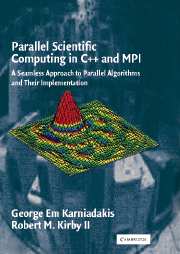 Parallel Scientific Computing in C++ and MPI
Parallel Scientific Computing in C++ and MPI Book contents
- Frontmatter
- Contents
- Preface
- Acknowledgments
- 1 Scientific Computing and Simulation Science
- 2 Basic Concepts and Tools
- 3 Approximation
- 4 Roots and Integrals
- 5 Explicit Discretizations
- 6 Implicit Discretizations
- 7 Relaxation: Discretization and Solvers
- 8 Propagation: Numerical Diffusion and Dispersion
- 9 Fast Linear Solvers
- 10 Fast Eigensolvers
- A C++ Basics
- B MPI Basics
- Bibliography
- Index
2 - Basic Concepts and Tools
Published online by Cambridge University Press: 05 October 2013
- Frontmatter
- Contents
- Preface
- Acknowledgments
- 1 Scientific Computing and Simulation Science
- 2 Basic Concepts and Tools
- 3 Approximation
- 4 Roots and Integrals
- 5 Explicit Discretizations
- 6 Implicit Discretizations
- 7 Relaxation: Discretization and Solvers
- 8 Propagation: Numerical Diffusion and Dispersion
- 9 Fast Linear Solvers
- 10 Fast Eigensolvers
- A C++ Basics
- B MPI Basics
- Bibliography
- Index
Summary
In this chapter we introduce the main themes that we will cover in this book and provide an introduction for each of them. We begin with a brief overview of C++ and define the two basic concepts of functions and classes as well as other syntactic elements of the language. We then introduce basic mathematical concepts that include elements of linear algebra, vector orthogonalization, and corresponding codes and software. Finally, we introduce parallel programming and review some generic parallel architectures as well as standard parallel algorithms for basic operations (e.g., the fan-in algorithm for recursive doubling). We also provide a brief overview of the main MPI commands.
INTRODUCTION TO C++
An ancient proverb states that the beginning of a thousand-mile journey begins with a single step. For us, this single step will be a brief overview of the C++ programming language. This introduction is not designed to be all-inclusive, but rather it should provide the scaffolding from which we will build concepts throughout this book. Admittedly, what you will read now may seem daunting in its scope, but as you become more familiar with the concepts found herein, you will be able to use the C++ language as a tool for furthering your understanding of deeper mathematical and algorithmic concepts presented later in the book. With this in mind, let us begin our thousand-mile journey with this first step.
- Type
- Chapter
- Information
- Parallel Scientific Computing in C++ and MPIA Seamless Approach to Parallel Algorithms and their Implementation, pp. 10 - 83Publisher: Cambridge University PressPrint publication year: 2003
